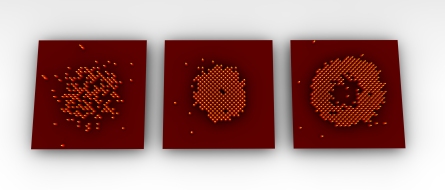
Simulation
Quantum simulators based on the laws of quantum physics will allow us to overcome the shortcomings of supercomputers and to simulate materials or chemical compounds
The design of aircraft, buildings, cars and many other complex objects makes use of supercomputers. By contrast, we cannot yet predict if a material composed of few hundred atoms will conduct electricity or behave as a magnet, or if a chemical reaction will take place. Quantum simulators based on the laws of quantum physics will allow us to overcome the shortcomings of supercomputers and to simulate materials or chemical compounds, as well as to solve equations in other areas, like high-energy physics.

Measured atom distribution of an ultracold quantum gas held in a two-dimensional crystal of light for the two distinct quantum phases of a Bose-Einstein condensate (BEC) (left) and Mott insulators with increasing particle numbers (middle & right).
Quantum simulators can be viewed as analogue versions of quantum computers, specially dedicated to reproducing the behaviour of materials at very low temperatures, where quantum phenomena arise and give rise to extraordinary properties. Their main advantage over all-purpose quantum computers is that quantum simulators do not require complete control of each individual component, and thus are simpler to build.
Several platforms for quantum simulators are under development, including ultracold atoms in optical lattices, trapped ions, arrays of superconducting qubits or of quantum dots and photons. In fact, the first prototypes have already been able to perform simulations beyond what is possible with current supercomputers, although only for some particular problems. This field of research is progressing very fast. Quantum simulators will aim to resolve some of the outstanding puzzles in material science and allow us to perform calculations that would otherwise be impossible. One such puzzle is the origin of high-Tc superconductivity, a phenomenon discovered about thirty years ago, but still a mystery in terms of its origin. The resolution of this mystery will open up the possibility of creating materials able to conduct electricity without losses at high temperatures, with applications in energy storage and distribution and in transportation.
For more information on Quantum Simulation, check out the topics below or the hand-picked educational videos in our Quantum Playlist.



